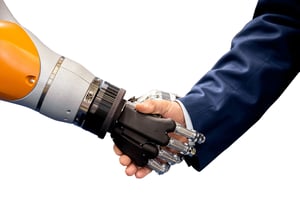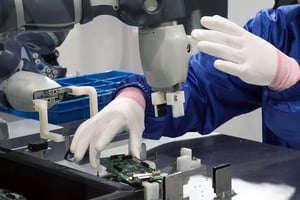 A type of robot growing in popularity in the industrial manufacturing industry is called a cobot, otherwise known as a collaborative robot. The reason for the growing popularity of cobots is their ability to work side by side with human operators to accomplish a task. With ever expanding technology, many fear it will make human workers obsolete. Robots are one of the top concerns. However, when it comes to cobots, they have one great difference from traditional industrial robots. Their design purpose is to work productively alongside humans. This will obviously have the benefit of human labor still required and an advanced form of technology assisting in the job process. Nobody wants to see human labor become obsolete. This is why more and more manufacturing operations are making use of cobots, as they integrate automation systems.
A type of robot growing in popularity in the industrial manufacturing industry is called a cobot, otherwise known as a collaborative robot. The reason for the growing popularity of cobots is their ability to work side by side with human operators to accomplish a task. With ever expanding technology, many fear it will make human workers obsolete. Robots are one of the top concerns. However, when it comes to cobots, they have one great difference from traditional industrial robots. Their design purpose is to work productively alongside humans. This will obviously have the benefit of human labor still required and an advanced form of technology assisting in the job process. Nobody wants to see human labor become obsolete. This is why more and more manufacturing operations are making use of cobots, as they integrate automation systems.
With cobots becoming more popular in the industry, understanding them and specifically how to implement them into the job process must be known. Therefore tip number one is arguably the most important. This tip is to understand what an operation hopes to gain from cobots. This doesn’t just refer to what a robot should do. It means, where will robots fit into the manufacturing process? Will the cobots be in tight quarters or a large space? What type of interaction will cobots have with human teammates? What parts should be added to cobots? Will the cobot be picking and lifting? Will loads be heavy or light? It is very important to ask questions about what the cobot’s purpose is. With proper planning, knowledge, and understanding of the purpose, operations will gain more from cobots.
 Tip number one and tip number two go hand in hand. DO NOT plug and play cobots. People often make the mistake of skipping tip number one and expect cobots to be purchased as they are and immediately work. But cobots are stand-alone machines. Parts such as loading units and grippers do not come with the robot and must be selected and paired with the cobots purpose. That is why cobots should never be used as a plug and play system. This makes tip number one even more important. Not only would trying to plug and play mess up the process of what they are being used for, they would never reach their full potential. Cobots are highly advanced machines and even though they are a simplified version of the traditional robot, they will not work with a simple purchase.
Tip number one and tip number two go hand in hand. DO NOT plug and play cobots. People often make the mistake of skipping tip number one and expect cobots to be purchased as they are and immediately work. But cobots are stand-alone machines. Parts such as loading units and grippers do not come with the robot and must be selected and paired with the cobots purpose. That is why cobots should never be used as a plug and play system. This makes tip number one even more important. Not only would trying to plug and play mess up the process of what they are being used for, they would never reach their full potential. Cobots are highly advanced machines and even though they are a simplified version of the traditional robot, they will not work with a simple purchase.
Equally as important as understanding what the role of the cobot is, is understanding the role of its human counterpart. With both working side by side, both need to have a clear goal in their process. Asking similar questions about purpose should be done with human workers as well. Are human workers performing different tasks in the process? Are they working in the same workspace? Does the human operator’s task dictate the cobot’s task? This is a team process where the common goals of both need to be thought through. When understanding what each others’ goals are, the efficiency of both humans and cobots will reach a maximum level.
 Once human operators understand the goal of the process, they must be trained properly to do so. Tip number 4 is to, train the human teammates properly. A cobot’s beauty is that it is built to work alongside a human. Because of this, humans needs to understand how to work alongside cobots. This could be in the form of safety or technical assistance. Cobots have safety features such as motion detection, padding, and emergency stop buttons. But that does not make them inherently safe. Human workers should be trained to know that. No matter how intelligent the cobot is, there is room for malfunctions. Not just safety malfunctions but also technical malfunctions. When a cobot is in need of maintenance, the human worker should be trained on how to fix it. Human teammates who work with cobots need to know everything about them. Proper training will allow for that.
Once human operators understand the goal of the process, they must be trained properly to do so. Tip number 4 is to, train the human teammates properly. A cobot’s beauty is that it is built to work alongside a human. Because of this, humans needs to understand how to work alongside cobots. This could be in the form of safety or technical assistance. Cobots have safety features such as motion detection, padding, and emergency stop buttons. But that does not make them inherently safe. Human workers should be trained to know that. No matter how intelligent the cobot is, there is room for malfunctions. Not just safety malfunctions but also technical malfunctions. When a cobot is in need of maintenance, the human worker should be trained on how to fix it. Human teammates who work with cobots need to know everything about them. Proper training will allow for that.
 Technology will continue to grow and therefore cobots will as well. That is why tip number 5 is to stay up to date on technology, particularly robots. Don’t allow your purchase and implementation of the cobot to stop you from staying up to date on technology. Continue to watch the cobot and its functions after installing. It is advised to not make major adjustments after implementation. Small adjustments can be made to the cobot if needed or recommended. Continue to read articles on what’s next for robotics. Keep in touch with cobot specialists. Research more tips that can help with implementation. The more you learn, the better you will understand cobots. All of that will result in major benefits for a manufacturing company. Staying up to date can be done in the form of research and understanding where the latest technology is heading.
Technology will continue to grow and therefore cobots will as well. That is why tip number 5 is to stay up to date on technology, particularly robots. Don’t allow your purchase and implementation of the cobot to stop you from staying up to date on technology. Continue to watch the cobot and its functions after installing. It is advised to not make major adjustments after implementation. Small adjustments can be made to the cobot if needed or recommended. Continue to read articles on what’s next for robotics. Keep in touch with cobot specialists. Research more tips that can help with implementation. The more you learn, the better you will understand cobots. All of that will result in major benefits for a manufacturing company. Staying up to date can be done in the form of research and understanding where the latest technology is heading.
Cobots play an important role in the future of industrial manufacturing. As Industry 4.0 begins evolving into Industry 5.0, those who have a better understanding of cobots and how to implement them will be prepared for the next stage. If these tips are used, cobots will create major manufacturing efficiencies for any company.
To learn how Radwell International can assist with your equipment maintenance
For a behind the scenes look at Radwell International


